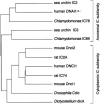Loss-of-function mutations in a human gene related to Chlamydomonas reinhardtii dynein IC78 result in primary ciliary dyskinesia
- PMID: 10577904
- PMCID: PMC1288361
- DOI: 10.1086/302683
Loss-of-function mutations in a human gene related to Chlamydomonas reinhardtii dynein IC78 result in primary ciliary dyskinesia
Abstract
Primary ciliary dyskinesia (PCD) is a group of heterogeneous disorders of unknown origin, usually inherited as an autosomal recessive trait. Its phenotype is characterized by axonemal abnormalities of respiratory cilia and sperm tails leading to bronchiectasis and sinusitis, which are sometimes associated with situs inversus (Kartagener syndrome) and male sterility. The main ciliary defect in PCD is an absence of dynein arms. We have isolated the first gene involved in PCD, using a candidate-gene approach developed on the basis of documented abnormalities of immotile strains of Chlamydomonas reinhardtii, which carry axonemal ultrastructural defects reminiscent of PCD. Taking advantage of the evolutionary conservation of genes encoding axonemal proteins, we have isolated a human sequence (DNAI1) related to IC78, a C. reinhardtii gene encoding a dynein intermediate chain in which mutations are associated with the absence of outer dynein arms. DNAI1 is highly expressed in trachea and testis and is composed of 20 exons located at 9p13-p21. Two loss-of-function mutations of DNAI1 have been identified in a patient with PCD characterized by immotile respiratory cilia lacking outer dynein arms. In addition, we excluded linkage between this gene and similar PCD phenotypes in five other affected families, providing a clear demonstration of locus heterogeneity. These data reveal the critical role of DNAI1 in the development of human axonemal structures and open up new means for identification of additional genes involved in related developmental defects.
Figures







References
Electronic-Database Information
-
- BLAST Sequence Similarity Search, http://www.ncbi.nlm.nih.gov/BLAST/
-
- GenBank, http://www.ncbi.nlm.nih.gov/Genbank/index.html (for DNAI1 cDNA, deduced protein sequence [accession number AF091619], intronic boundaries and sequences of primers [accession numbers AF190477–AF190496], Chlamydomonas IC78 [accession number U19120] and IC69 [accession number X55382], sea urchin IC2 [accession number D38538] and IC3 [accession number D28863], rat IC74 [accession number X66845], rat dynein cytoplasmic intermediate chain–2A [accession number U39044], mouse Dnci1 [accession number AF063229] and Dnci2 [accession numberAF063231], Drosophila Cdic [accession number AF070687], Dictyostelium dicA [accession number U25116], and human DNCI1 [accession number AF063228])
-
- Online Mendelian Inheritance in Man (OMIM), http://www.ncbi.nlm.nih.gov/Omim/ (for PCD [MIM 242650] and Kartagener syndrome [MIM244400])
References
-
- Afzelius BA (1976) A human syndrome caused by immotile cilia. Science 193:317–319 - PubMed
-
- ——— (1985) The immotile-cilia syndrome: a microtubule-associated defect. CRC Crit Rev Biochem 19:63–87 - PubMed
-
- Asai DJ, Beckwith SM, Kandl KA, Keating HH, Tjandra H, Forney JD (1994) The dynein genes of Paramecium tetraurelia. Sequences adjacent to the catalytic P-loop identify cytoplasmic and axonemal heavy chain isoforms. J Cell Sci 107:839–847 - PubMed
-
- Blair DF, Dutcher SK (1992) Flagella in prokaryotes and lower eukaryotes. Curr Opin Genet Dev 2:756–767 - PubMed
Publication types
MeSH terms
Substances
Associated data
- Actions
- Actions
- Actions
- Actions
- Actions
- Actions
- Actions
- Actions
- Actions
- Actions
- Actions
- Actions
- Actions
- Actions
- Actions
- Actions
- Actions
- Actions
- Actions
- Actions
- Actions
- Actions
- Actions
- Actions
- Actions
- Actions
- Actions
- Actions
- Actions
- Actions
LinkOut - more resources
Full Text Sources
Other Literature Sources
Medical
Molecular Biology Databases

